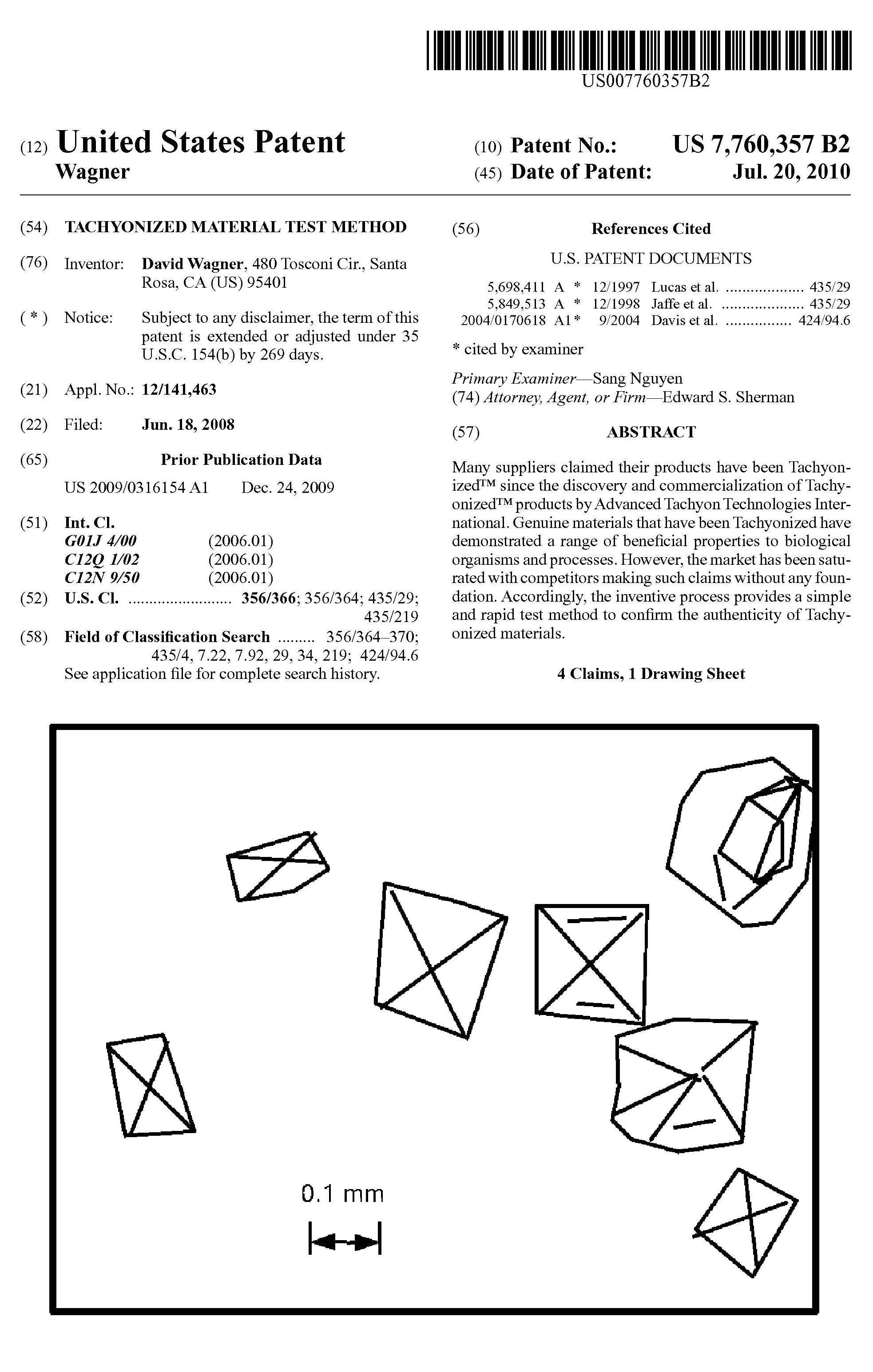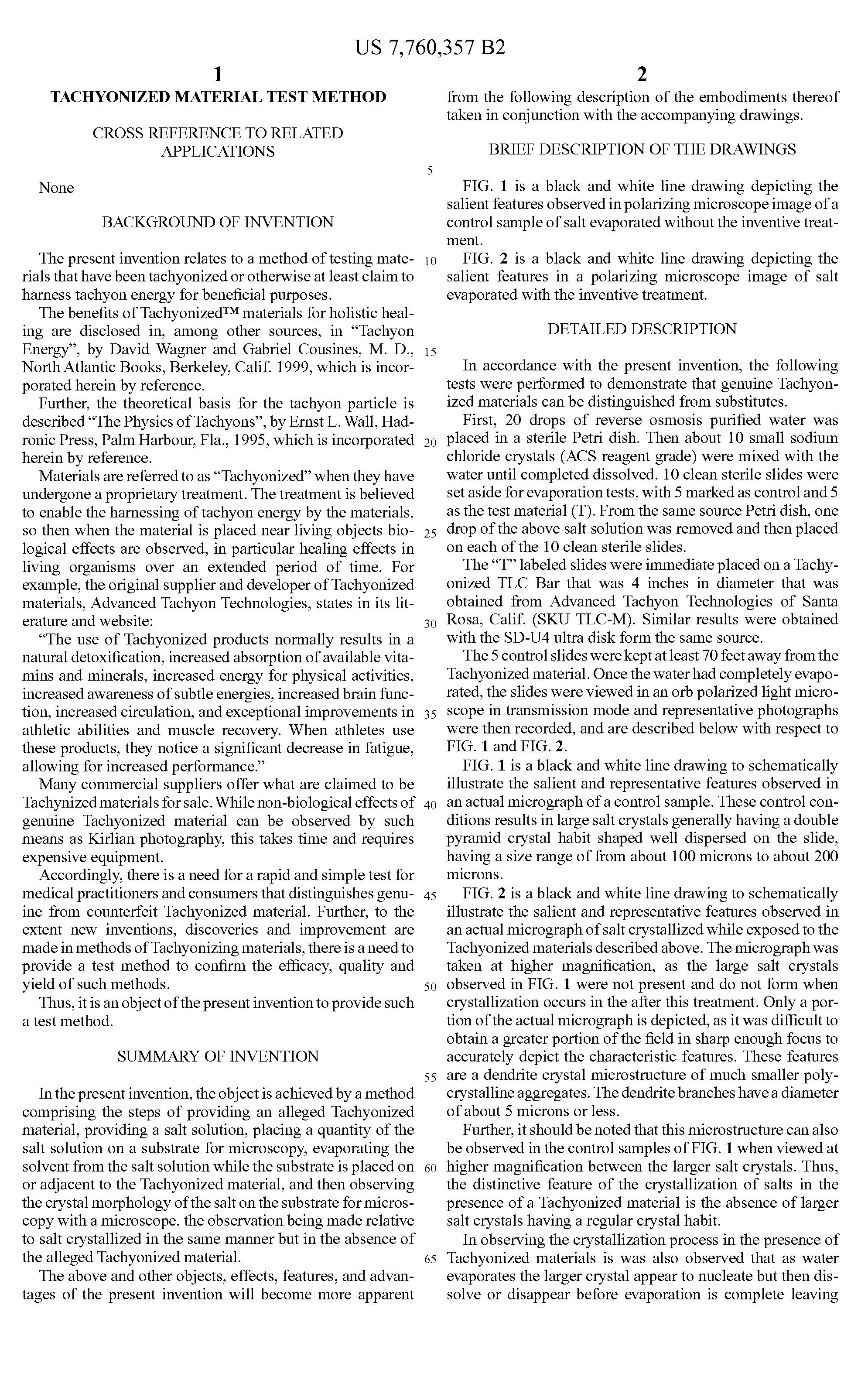THE WORLDS ONLY USA PATENT IN THE FIELD OF TACHYONIZATION™
Tachyons Are Real—and Now, They're Patented.
The U.S. Government Has Officially Recognized the Only Scientific Method for Testing Tachyonized™ Materials.
In a remarkable milestone for the field of quantum healing and energy medicine, the United States Patent and Trademark Office has granted U.S. Patent 7,760,357 for the Tachyonized Material Test Method, a breakthrough invention by David Wagner—founder of Advanced Tachyon Technologies International (ATTI) and the acknowledged pioneer behind the Tachyonization™ process.
This patent represents the first and only officially recognized method for testing the authenticity of Tachyonized materials. It legally validates the presence and effect of Tachyon energy in matter—something once considered purely theoretical. More than just a scientific breakthrough, this achievement provides government-backed proof that Tachyonized materials produce measurable, repeatable effects that cannot be replicated by frequency-based tools or imitations.
The World’s First—and Only—Patent in Tachyon Testing
Granted on July 20, 2010, the U.S. Patent covers a specific and reproducible method to test whether a material has truly been Tachyonized using Wagner’s proprietary process. The method involves using polarized light microscopy to observe crystallization patterns in salt solutions. When exposed to genuine Tachyonized materials, salt crystals form in distinct dendritic structures that differ dramatically from those in non-Tachyonized environments.
This patented technique allows for scientific validation of any product claiming to be Tachyonized. To date, no competitor has successfully passed this test—proving that only ATTI's Tachyonized products meet the standard of authenticity established by the patent.
A Scientific Triumph with Global Impact
Before Wagner’s discovery in 1990, terms like “tachyon,” “Tachyonization,” and “Tachyonized” lived only in the realm of abstract theory. Thanks to decades of innovation, rigorous testing, and global education, Tachyons have moved from science fiction into scientific fact.
Through this patent, the process of Tachyonization™ is now recognized as a legitimate, transformative phenomenon—proven to create negentropic effects that shift biological systems from chaos to coherence, from disorder to vibrant balance. This negentropic property is a cornerstone of quantum healing, as it reflects the movement toward health, regeneration, and equilibrium on a cellular and energetic level.
From the Fringe to the Forefront of Wellness
The issuance of this patent fundamentally reshapes the narrative around Tachyon energy. What was once dismissed as pseudoscience has now been placed firmly within the purview of measurable alternative health solutions. Tachyonized™ materials, especially those developed by ATTI, are now being used across 153 countries in applications ranging from personal health and EMF protection to enhanced athletic recovery, agriculture, and environmental restoration.
Still, despite the legitimacy brought by the U.S. patent, many in the public remain unaware of this advancement. Misleading claims from imitators continue to cloud the marketplace. The existence of this patent now provides a clear, legal line in the sand—empowering individuals and professionals alike to verify authenticity and reject counterfeits.
The Sole Licensee: University of Integrated Science
As the sole licensee of this landmark patent, the University of Integrated Science plays a pivotal role in advancing education and research into Tachyon energy. This partnership ensures that the legacy of this invention is preserved, propagated, and continually applied in cutting-edge scientific and spiritual contexts.
A New Era Has Begun
The significance of U.S. Patent 7,760,357 cannot be overstated. It affirms that Tachyons are real, their effects are measurable, and their energy can be harnessed through a precise and unreplicable process. It validates over 30 years of dedicated work by David Wagner and the team at Advanced Tachyon Technologies.
This is not just a scientific paper—it is a beacon of truth in a field that has long been shrouded in misunderstanding. Tachyons have crossed the threshold of theory into tangible application. And with that step, a new era of healing, coherence, and evolution has begun.
For those seeking proof, the answer is now unequivocal: Tachyons are real. The patent proves it. The future depends on it.




